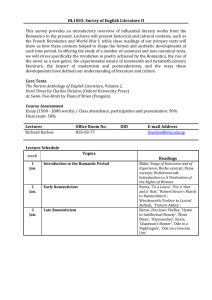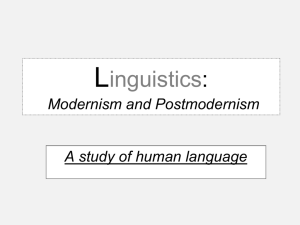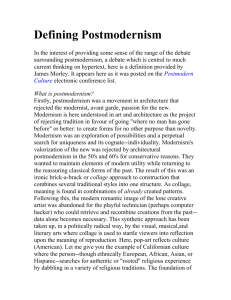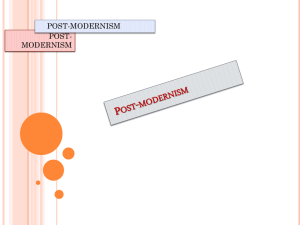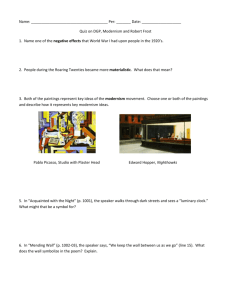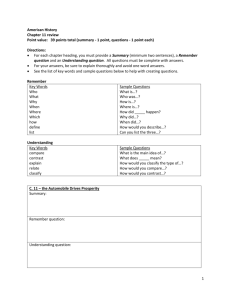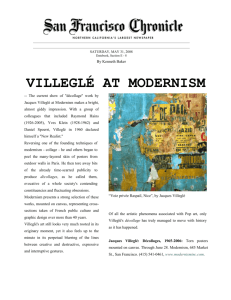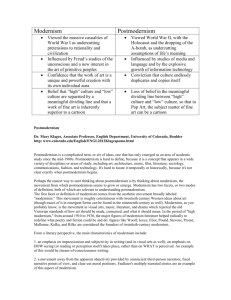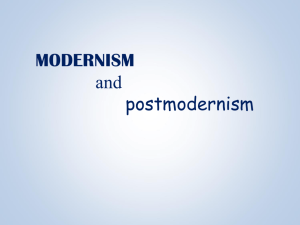Postmodernism 2011 PPT
advertisement
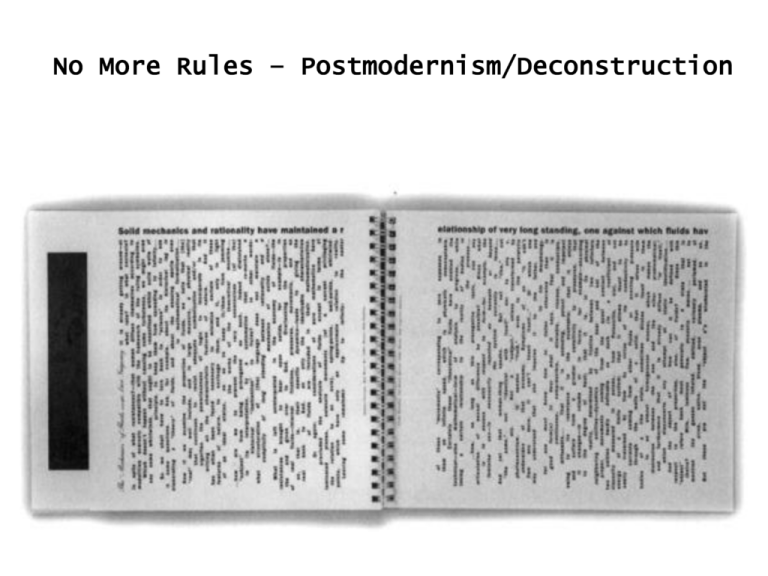
No More Rules – Postmodernism/Deconstruction http://www.youtube.com/watch?v=JtyjdkkloWQ Modernism • Modernism is a tendency rooted in the idea that the "traditional" forms of art, literature, religious faith, social organization and daily life had become outdated; therefore it was essential to sweep them aside. Modernism • Modernism encouraged the reexamination of every aspect of existence, from commerce to philosophy, with the goal of finding that which was "holding back" progress, and replacing it with new, and therefore better, ways of reaching the same end. Modernism • In this it drew on previous revolutionary movements, including liberalism and communism. Postmodernism • In art and graphic design, the habits of this approach involve removing a central, organizing theme, giving equal prominence to disparate elements, and bringing the background to the foreground. • Vattimo, Gianni, The End of Modernity: Nihilism and Hermeneutics in Postmodern Culture, Baltimore: John Hopkins University Press, 1988 Wolfgang Weingart Dan Friedman Cover for WET magazine,desi gned by April Greiman, 1979. April Greiman • During the late 1970s, April Greiman was acclaimed for her postmodernist experimentation. (In the 1970s and '80s, increasing numbers of women entered the graphic-design field and achieved prominence.) Her dynamic typographic innovations and colourful montages were often made in collaboration with photographer Jayme Odgers. • April Greiman • http://vids.myspace.com/index.cfm?fusea ction=vids.individual&videoid=16191055 WET magazine • A cover for WET magazine, for example, evokes the vibrant cultural scene in southern California. In this work from 1979, a colour photocopy of singer Rick Nelson, collaged images from magazines, Japanese papers, and airbrushed blends of colour are combined into a cohesive design. Postmodernism • By the late 1970s, many international architectural, product, and graphic designers working in the Modernist tradition thought that the movement had become academic and lost its capacity for innovation. Poster for a Michael Graves exhibition, designed by William Longhauser, 1983. Postmodernism • Younger designers challenged and rejected the tenets of Modernism and questioned the “form-follows-function” philosophy that came to be associated with the diluted, corporate version of Modernism that derived from the International Typographic Style. Keedy By Jeffery Keedy This text was first published in 1998 in Emigre #47. In 1989 I designed a typeface to use in my design work for experimental arts organizations like Los Angeles Contemporary Exhibitions and CalArts. I called the typeface Bondage Bold. Rudy Vander Lans saw it in some of my work and wanted to sell it through Emigre. After adding a regular weight, normalizing the spacing, cleaning up the drawings (with Zuzana Licko's guidance), and changing the name to Keedy Sans, it was finally released on an unsuspecting public in 1991. Postmodernism • Designers began to establish and then violate grid patterns; to invert expected forms; to explore historical and decorative elements; and to inject subjective—even eccentric—concepts into design. This reaction to Modernist developments is called postmodernism, and it took design in many new directions. What is postmodernism? ‘…unlike Modernism, Postmodernism starts from the assumption that grand utopias are impossible. It accepts that reality is fragmented and that personal identity is an unstable quantity transmitted by a variety of cultural factors. Postmodernism advocates an irreverent, playful treatment of one's own identity, and a liberal society.’ www.ffotogallery.org/th-edu/glossary.htm Not so much a stage after modernism, more an impulse to deconstruct totalising systems of knowledge, meaning or belief grand narratives in the terminology of French philosopher Jean-François Lyotard (religions, for example, or grand political theories such as capitalism or communism, or nationalisms, or humanist theories of identity). The postmodern condition , for Lyotard, is that of living without such systems or myths; for Derrida this is about celebrating this advent of an open future. ... www.adamranson.freeserve.co.uk/critical%20concepts.htm What is postmodernism? • A worldview that emphasizes the existence of different worldviews and concepts of reality, rather than one "correct or true" one. Whereas modernism emphasized a trust in the empirical scientific method, and a distrust and lack of faith in ideologies and religious beliefs that could not be tested using scientific methods; postmodernism emphasizes that a particular reality is a social construction by a particular group, community, or class of persons. www.greeleynet.com/~cnotess/gloss.htm • late-twentieth-century critical, literary, and performance movement that reacts to modern art and literature; postmodernists suggest that truth is no longer verifiable, and that new art forms are best created by freely mixing previous styles and themes. filmplus.org/thr/dic4.html No More Rules - Graphic Design and Postmodernism by Rick Poynor, 2003 Design: Kerr Noble Image: Edward Fella Client: Laurence King Publishing Edward Fella • Edward Fella practiced as a commercial artist in Detroit, Michigan for 30 years before returning to study graphic design at the Cranbrook Academy of Art. While at Cranbrook, and currently as a teacher at Cal Arts, his idiosyncratic style has influenced many young graphic designers throughout the United States and beyond. A special project created by London based graphic designer Phil Baines, Titled, "Clear Enough to Read," which is a continuation of his St. Martin's School of Art thesis "The Bauhaus Mistook Legibility for Communication." Exhibition graphics for Gio Ponti - A World, 2002 Design: Kerr Noble Client: Design Museum, London Barbara Kruger Cindy Sherman, Untitled Film Still #54. 1980. ©1997 The Museum of Modern Art, New York Thus, to give an example, we can see how Cindy Sherman became a key figures in this respect of postmodern reference. Sherman’s early work referred exclusively to the imagery of trashy Hollywood films (of which there have been many). Of course, much art has traditionally been dependent on reference to other previous ‘texts’, but this was about situating the work within a historical tradition of great artists (sic). Cleverly, Sherman’s famous early photographs were captioned as Untitled Film Stills. ‘Untitled’, indicating that you can give them any meaning, then ‘Film Still no…’ instilling the notion that the image does indeed refer to an actual specific existing film’ (Hollywood ‘B movies’ in Sherman’s work). In short: ‘here is a picture from a film, but I am not going to tell you which one’, a message complicated by the fact that the photographs were not actual films stills. Jeff Wall, A Sudden Gust of Wind (After Hokusai), (1993) Hokusai's views of Mt. Fuji deconstruction / poststructuralism Jacques Derrida initiated the concept of deconstruction in his book Of Grammatology, published in France 1967, translated into English 1976 "Deconstruction rejected the project of modern criticism, and focused not on themes and imagery of its objects but on the structure, the system that frame their production." It attacks the oppositions put forth by the structurralists by showing how the one (negative) inhabits the other. (nature and culture) constructed oppositions to elevate one over the other, support ecological destruction (culture is supreme over nature). derrida states that culture is embedded in nature. Glas, book, by Jacques Derrida. English Edition. 1986, Univeristy of Nebraska Press. Designed by Richard Eckersley. source: Lupton/Miller, Design Writing Research, 1996. Photography Between Covers: The Dutch Documentary Photobook after 1945, book, designed by Fred Struving, 1989. footnotes and traditional marginalia occupy the centre of this bilingual book. source: Lupton/Miller, Design Writing Research, 1996. why is deconstruction so important? it refutes the neutrality of signs (see Barthes) the idea that cultural forms fabricate what we view as natural - race, class, sexuality, etc. --- see feminism, multiculturalism, etc. it attacked our conventions by questioning authority. reading is an example. what is the role of the author? the reader? (by many this has meant an openness of meaning) death of the author = interior self is constructed by external systems and technologies Since the surfacing of the term “deconstruction” in design journalism in the mid-1980s, the word has served to label architecture, graphic design, products, and fashion featuring chopped up, layered, and fragmented forms imbued with ambiguous futuristic overtones. Post Modernism http://www.youtube.com/watch?v=i_l5MJDssGE http://www.youtube.com/watch?v=9ZdQVxUNjo0&feature=PlayList&p=7 CA082F221C9C24A&playnext=1&index=6 The Decentering of the Subject Poststructural critics have called into question the very existence of the human "subject" or "self" posited by "humanism." The traditional view of individuals in society privileges the individual's coherent identity endowed with initiative, singular will, and purposefulness. However, this traditionalist concept is no longer seen as tenable in a poststructuralist view of human subjectivity. The Fundamental Importance of the Reader With the destabilizing or de-centring of the author and in more general terms of language as a system, the reader or interpreter has become the focal point of much post-structural theorizing. Strange Attractors, book, designed by Marlene McCarty and Tibor Kalman,1989 The New Museum of Modern Art. source: Lupton/Miller, Design Writing Research, 1996. Post Modernism http://www.youtube.com/watch?v=mmZycBS2FKU http://gds.parkland.edu/gds/!lectures/history/1975/postmodern.html
